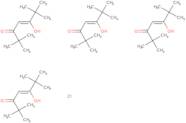Zirconium tetrakis(2,2,6,6-tetramethyl-3,5-heptanedionate)
CAS : 18865-74-2
Ref. 3D-TAA86574
| 5g | Arrêté | ||
| 10g | Arrêté | ||
| 25g | Arrêté | ||
| 50g | Arrêté | ||
| 100g | Arrêté |
Informations sur le produit
- 2,2,6,6-Tetramethylheptane-3,5-Dione-Zirconium (4:1)
- 3,5-Dihydroxy-2,2,6,6-Tetramethylheptane-3,4,5-Triyl-Zirconium (4:1)
- 3,5-Heptanedione, 2,2,6,6-tetramethyl-, zirconium complex
- NSC 174883
- Tetrakis(2,2,6,6-Tetramethyl-3,5-Heptanedionate)Zirconium
- Tetrakis(2,2,6,6-Tetramethyl-3,5-Heptanedionato)Zirconium
- Tetrakis(2,2,6,6-Tetramethyl-3,5-Heptanedionato)Zirconium(Iv)
- Tetrakis(2,2,6,6-tetramethyl-3,5-heptanedionato)zirconium (IV), (Zr(TMHD)4)
- Tetrakis(2,2,6,6-tetramethyl-3,5-heptanedionato-κO<sup>3</sup>,κO<sup>5</sup>)zirconium
- Tetrakis(2,2,6,6-tetramethylheptane-3,5-dionato)zirconium
- Voir d'autres synonymes
- Tetrakis(dipivaloylmethanato)zirconium
- Zirconium (Iv) 2,2,6,6-Tetramethyl-3,5-Heptanedionate
- Zirconium Tetrakis (Dipivaloylmethanate)
- Zirconium Tetrakis(2,2,6,6-Tetramethyl-3,5-Heptanedionate)
- Zirconium tetra(2,2,6,6-tetramethylheptanedioate)
- Zirconium tetrakis(dipivaloylmethanato)
- Zirconium tetrakis(dipivaloylmethane)
- Zirconium, tetrakis(2,2,6,6-tetramethyl-3,5-heptanedionato)-
- Zirconium, tetrakis(2,2,6,6-tetramethyl-3,5-heptanedionato-O,O′)-
- Zirconium, tetrakis(2,2,6,6-tetramethyl-3,5-heptanedionato-κO,κO′)-
- Zirconium, tetrakis(2,2,6,6-tetramethyl-3,5-heptanedionato-κO<sup>3</sup>,κO<sup>5</sup>)-
- Zr(Tmhd)4
- Zirconium, tetrakis(2,2,6,6-tetramethyl-3,5-heptanedionato-κO3,κO5)-
Zirconium tetrakis(2,2,6,6-tetramethyl-3,5-heptanedionate) is a high melting ester compound that has been used in the production of ferroelectric materials. Zirconium tetrakis(2,2,6,6-tetramethyl-3,5-heptanedionate) is a zirconium based material with a molecular weight of 534.8 g/mol. It has shown to be an efficient monolayer precursor and can be used to produce nanodots in the range of 10µm. The reaction mechanism involves the formation of an ionic bond between zirconium cations and hydroxide anions at the interface with water. This interaction leads to the displacement of hydrogen ions from water molecules and the formation of hydroxyl radicals on the surface. These radicals are able to react with organic compounds at room temperature to form





